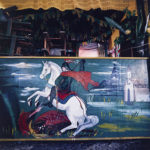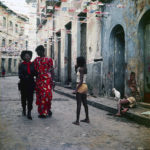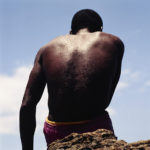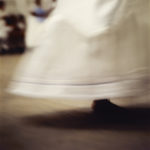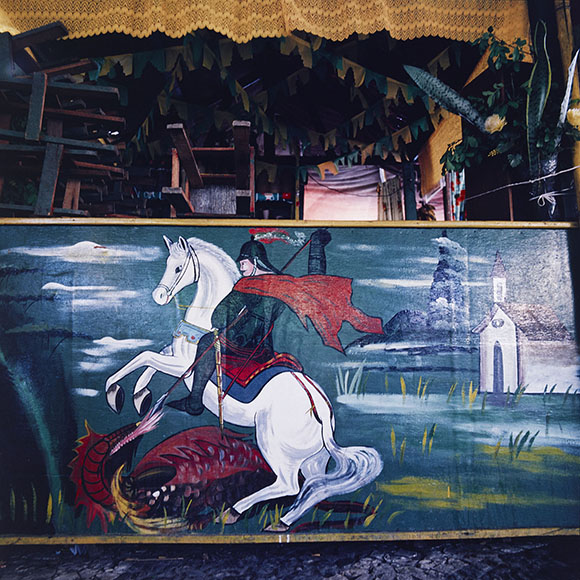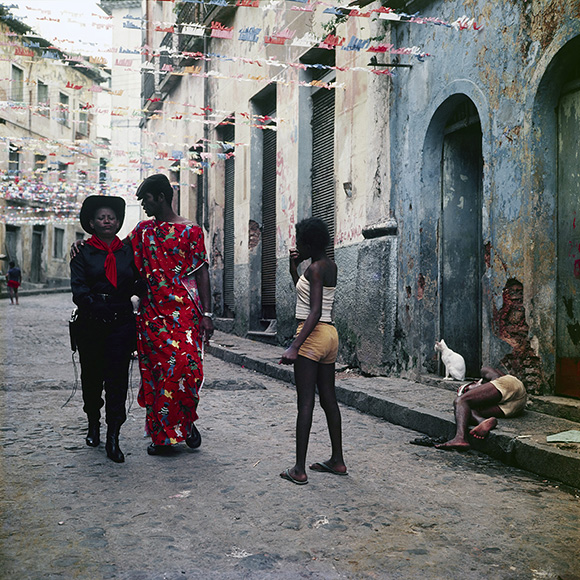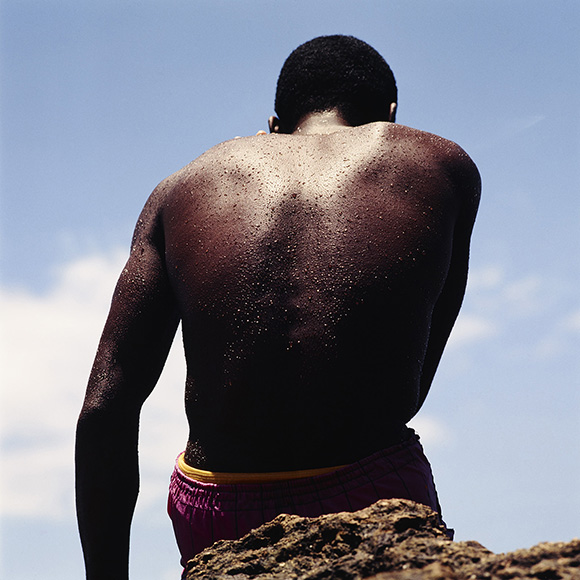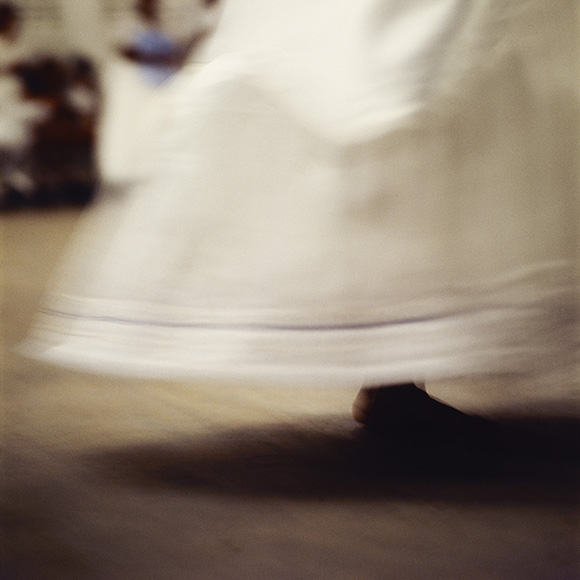Was born on April 20, 1947, in the city of Salvador, Bahia. He has passed away in the same town on August 9, 2009. He has started his activities as a photographer and sculptor in 1965, when he was awarded at the 1st Bienal de Artes Plásticas da Bahia and, later during the same year, his first solo exhibition was released. He has lived in New York, from 1968 to 1970. At the 11th Bienal Internacional de São Paulo in 1971, he had a special room and received the Prêmio Governador do Estado de São Paulo Sculpture Award. A reference in contemporary world photography, immersed in the mythical world and the nature of Brazil, his work has an entry in the Encyclopédie Internationale des Photographes, Carole Naggar, Édition de Seuil, Paris, 1982; Encyclopédie Internationale des Photographes, 1939-1984, Michel Auer, Éditions Camera Obscura, Berne, 1984; and the Photographic Dictionnaire Mondial, Larousse, Paris, 1994. Mario Cravo Neto has produced an art which expresses the culture of his land, recognized internationally with nine awards and 14 books published in several countries, in individual and collective exhibitions in Brazil and abroad, and for integrating collections of several public and private museums.
N.A.
At the phone, after inviting him to the interview, Mario Cravo Neto, a friend since our adolescence on the streets of Bahia, at a moment where he was continuing his brilliant creative activity, with a new book and a new exhibition, he started our conversation, reproducing at the opening, after telling me “of course I will answer”:
From our great poet Bob Dylan, here is the song we always used to quote: Don’t Think Twice, It’s All Right.
An’it ain’t no use to sit and wonder why, babe
If you don’t know by now …
When your rooster crows at the break of dawn
Look out your window and I’ll be gone…
But don’t think twice, it’s all right
So we can now resume the path of the interview.
Your photos have a non-transferable mark. They are truly personal. They are immediately identified as Mario Cravo Neto’s. What led you, within the international contemporary scene (you are an international artist after all), to this creation and to this production?
Is that true? Or were they some of them, or one of the facets I practice which made me better known? Here we have pictures from several years ago and a couple of recent ones, chosen and put together, in diptychs or triptychs, sometimes solo – all coming from a poetic process that emerges from some kind of aroma expanding its source in its tributaries. More specifically, we are talking about 45 years of devotion to the creative practice.
Your photos are neither reports nor narratives. They are more like documents. They are anthropological. They are about the drama of a people, of a man. What does photography mean for you? Is it just work? Or is it a worldwide communication expression? Or is it simply an art, the artwork you create?
I see it more specifically as a slight drama; document and anthropology have never interested me. I would say that what I do is an expression of “myself” – an expression that has no clear meaning in Portuguese. Everything else doesn’t matter to me, I am completely indifferent to photography or the fact I’m communicating with the world, because this is not the meaning of what I practice. Since early on, I do what I like, and only now I have come to the conclusion that, while trying to do what you like, you also have to try the other side, which is what you don’t like. In my twenties, I’ve spent a year in bed without moving, I did so much stuff I loved at a time when I was forced to do what I didn’t like, because I was unable to move from there. Forty-one years later, I find myself in the same situation, and for this very reason this exhibition was kept from December 2007 to June 2008. So, do I like what I’m creating? Yes, because I no longer do what we initially designed, we are in another moment and in another space – thus the title of the show that at that time still didn’t exist: The Resting Arrow. (A Flecha em Repouso)
The body in your photos, whether it be from humans, things, animals, the whole or their details, portraits, all of them can be seen at several periods of your work; they are revealing of the intimate of each. What makes you seek to capture the soul of everything and everyone?
The body in the photograph? Yes, the body in my work has always been my body and my spirit, one doesn’t exist without the other, it’s imbued with a mythical/poetic background. Reading Bertrand Russell, a great author which the younger people probably don’t know much about – in the book Mysticism and Logic, I have found the text referring to Zeno, the Eleatic – which is attached in the show’s catalog. I have found this reference three years ago, I copied the text and lost the boo, I just can’t find it. What can I do if things just happen like that with me all the time.
The body in your photograph, despite its beauty, is not erotic seduction or exoticism, but the body in its dignity of human body. Which thoughts lead you to create – in your undeniably beautiful pictures – the body through these characteristics?
Changing the script of the questions a little bit to update it with context: there is matter and spirit, mysticism and logic, with their variables depending on the cultural context in which they apply. I don’t believe that “body” is synonymous with matter anymore, even physicists are treating it as subtle matter today. In our Bahian culture, if we look around, we find trees and stones eating, bodies bathing, heads drinking… so which universe are we talking about?
Your photos, although individual, when viewing separately you are able to notice they each have their own autonomy, but they seem to us always created as part of an essay, an exhibition, a book, and they have a theme, a revelation. Are your photographs a requirement from this revelation or a demanding revelation?
In any level, life is revelation. We need more understanding, more love, more positive thinking, fewer problems, outrages, arguments and cheating. Sometimes I feel tired of being human.
How do you choose a theme to develop? Is there a project? A concept? How do you construct your themes?
The theme shows up when the work or artwork is finished. Themes are just starting points, they are never the end of the line, where you throw the towel.
As for composition, much of your work is performed in a studio, with infinite background. What leads you to seek this intentionality for your scene? How is the game of shadow and light made evident there? What generates the creation of this composition?
What generates the creation of this composition in the game of shadow and light? In broader terms, it is a very old question: the sun rises and the earth’s surface glows brighter; then later the shadows, like glaciers, disappear or are dispersed; then comes noon and everything gets flat. Post noon, the process resumes in the reverse direction, and the day passes by. The artist does the same thing with a small difference – he undoes what he dislikes, tears off, breaks up and throws away; some of us cut their own ears!
Do you consider yourself an artist of space and light? Is this a way to learn your art?
Way to learn art is a refrain; in art there is nothing to learn. Either you perform the drama or you consume yourself in the drama.
What does memory mean for your art? What does memory mean for you? Developing further the question, What role does ancestry play in the creation of your work?
Just look around, then turn a little and pay attention to yourself while you walk through the garden where the symbols will bring your attention to what matters – it is expressed in the form of a dream and it is up to each one of us to interpret it. That’s where the question lies! Our friend Carl already solved this question: “Sensation is to establish that something exists, thinking tells us what it means, feeling what its value is, and intuition surmises whence it comes and whither it goes.” – Jung.
What influences do you consider essential for becoming the photographer you are today, with such great accuracy, precision, rare beauty and humanity?
It’s not about influences, but about a certain kind of inherited temperament that each individual brings within himself. This temperament must be tamed so that it becomes milder, so that it may soften our hallucinations.
(Interview/June, 2008)


